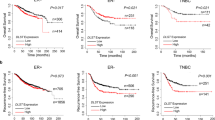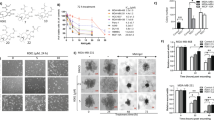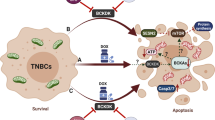Abstract
Bcl-2 has been associated with both oxidative and antioxidative effects in vivo. Moreover, despite evidence that Bcl-2 is antiapoptotic by virtue of its effect on reactive oxygen species and their scavengers, Bcl-2 exerts its antiapoptotic effects even under anaerobic conditions. The reasons for the variable relationship between Bcl-2 and reactive oxygen species are not clear. The present studies demonstrate that the impact of Bcl-2 on glutathione (GSH) metabolism is cell line-dependent. Bcl-2 overproduction in PC12 cells is associated with increased functional thiol reserves, increased reductive activation of chemotherapeutic prodrugs, and GSH accumulation after treatment with N-acetylcysteine. In contrast, Bcl-2-overproducing MCF-7 breast cancer cells demonstrate neither altered GSH handling nor potentiation of chemotherapeutic prodrug reduction. These findings indicate that the effects of Bcl-2 on GSH handling are millieu-dependent. This could account for the variable effects of Bcl-2 in in vivo systems. Furthermore, since our previous studies have demonstrated that reduction-dependent prodrugs may be useful chemotherapeutic agents against tumors that demonstrate altered GSH handling, screening in vitro for alteration of GSH handling may predict responsiveness of such tumors to these reduction-dependent agents.
This is a preview of subscription content, access via your institution
Access options
Subscribe to this journal
Receive 50 print issues and online access
$259.00 per year
only $5.18 per issue
Buy this article
- Purchase on Springer Link
- Instant access to full article PDF
Prices may be subject to local taxes which are calculated during checkout


Similar content being viewed by others
References
Albrecht H, Tschopp J and Jongeneel CV. . 1994 FEBS Lett. 351: 45–48.
Beerman TA, Poon R and Goldberg IH. . 1977 Biochim. Biophys. Acta. 475: 294–306.
Beham AW and McDonnell TJ. . 1996 Proc. Am. Assoc. Cancer Res. 37: 224.
Boise LH, Gonzalez-Garcia M, Postema CE, Ding L, Lindsten T, Turka LA, Mao X, Nunez G and Thompson CB. . 1993 Cell 74: 597–608.
Bonetti A, Zaninelli M, Pavanel F, Sperotto L, Molino A, Pelosi G, Cetto GL, Biolo S and Piubello Q. . 1996 Proc. Am. Assoc. Cancer Res. 37: 192.
Campos L, Rouault J-P, Sabido O, Oriol P, Roubi N, Vasselon C, Archimbaud E, Magaud J-P and Guyotat D. . 1993 Blood 81: 3091–3096.
Carlburg I and Mannervik B. . 1985 Meth. Enzymol. 113: 484–489.
Chin D-H, Zeng C-H, Costello CE and Goldberg IH. . 1988 Biochemistry 27: 8106–8114.
Cortazzo M and Schor NF. . 1996 Cancer Res. 56: 1199–1203.
DeGraff WG and Mitchell JB. . 1985 Cancer Res. 45: 4760–4762.
DeGraff WG, Russo A and Mitchell JB. . 1985 J. Biol. Chem. 260: 8312–8315.
Dole M, Nunez G, Merchant AK, Maybaum J, Rode CK, Bloch CA and Castle VP. . 1994 Cancer Res. 54: 3253–3259.
Dole MG, Jasty R, Cooper MJ, Thompson CB, Nunez G and Castle VP. . 1995 Cancer Res. 55: 2576–2582.
Gelbard HA, Boustany RM and Schor NF. . 1997 Pediatr. Neurol. 16: 93–97.
Halliwell B and Gutteridge JMC. . 1985 TINS 22–26.
Hartsell TL, Yalowich JC, Ritke M, Martinez AJ and Schor NF. . 1995 J. Pharm. Exp. Thera. 275: 479–485.
Hartsell TL, Hinman LM, Hamann PR and Schor NF. . 1996 J. Pharm. Exp. Thera. 277: 1158–1166.
Hubel CA, Kagan VE, Kisin ER, McLaughlin MK and Roberts JM. . 1997 Free Radical. Biol. Med. 23: 596–609.
Jacobson MD and Raff MC. . 1995 Nature 374: 814–816.
Kane DJ, Sarafian TA, Anton R, Hahn H, Gralla EB, Valentine JS, Ord T and Bredesen DE. . 1993 Science 262: 1274–1277.
Kluck RM, Bossy-Wetzel E, Green DR and Newmeyer DD. . 1997 Science 275: 1132–1136.
Langmuir ME, Yang J-R, LeCompte KA and Durand RE. . 1996 Fluorescence Microscopy and Fluorescent Probes. Plenum Press, NY pp. 229–234.
Maeda H. . 1994 Enediyne Antibiotics as Antitumor Agents. Borders DB and Doyle TW. (eds).. Marcel Decker: NY pp. 363–381.
Narayanan V. . 1997 Pediatr Neurol. 16: 9–13.
Reber U, Wullner U, Trepel M, Baumgart J, Seyfried J, Klockgether T, Dichgans J and Weller M. . 1998 Biochem. Pharmacol. 55: 349–359.
Schor NF. . 1992 J. Clin. Invest. 89: 774–781.
Schor NF, Tyurina YY, Fabisiak JP, Tyurin VA, Lazo JS and Kagan VE. . 1999 Brain Res. 831: 125–130.
Seelig GF and Meister A. . 1985 Meth. Enzymol. 113: 379–389.
Smith TK, Nylander KD and Schor NF. . 1998 Dev. Brain Res. 105: 175–180.
Steinman HM. . 1995 J. Biol. Chem. 270: 3487–3490.
Stoyanovsky DA, Goldman R, Jonnalagadda SS, Day BW, Claycamp HG and Kagan VE. . 1996 Arch. Biochem. Biophys. 330: 3–11.
Teixeira C, Reed JC and Pratt MA. . 1995 Cancer Res. 55: 3902–3907.
Tietze F. . 1969 Analyt. Biochem. 27: 502–522.
Tyurina YY, Tyurin VA, Carta G, Quinn PJ, Schor NF and Kagan VE. . 1997 Arch. Biochem. Biophys. 344: 412–433.
Wood KA and Youle RJ. . 1994 Ann. NY. Acad. Sci. 738: 400–407.
Wood KA and Youle RJ. . 1995 J. Neurosci. 15: 5851–5857.
Yang J, Liu X, Bhalla K, Kim CN, Ibrado AM, Cai J, Peng T-I, Jones DP and Wang X. . 1997 Science 275: 1129–1132.
Acknowledgements
The authors wish to acknowledge the expert technical assistance of Karen D Nylander. This work was funded by grants CA74289 from the National Institutes of Health and DAMD17-97-1-7247 from the Department of the Army. YY Tyurina was partly supported by the International Neurological Science Fellowship Program #F05 NS 10669 administered by NIH/NINDS in collaboration with WHO, Unit of Neuroscience, Division of Mental Health and Prevention of Substance Abuse.
Author information
Authors and Affiliations
Rights and permissions
About this article
Cite this article
Schor, N., Rudin, C., Hartman, AR. et al. Cell line dependence of Bcl-2-induced alteration of glutathione handling. Oncogene 19, 472–476 (2000). https://doi.org/10.1038/sj.onc.1203324
Received:
Revised:
Accepted:
Published:
Issue Date:
DOI: https://doi.org/10.1038/sj.onc.1203324
Keywords
This article is cited by
-
A comparative study of tellurite toxicity in normal and cancer cells
Molecular & Cellular Toxicology (2012)
-
Apoptosis and glutathione: beyond an antioxidant
Cell Death & Differentiation (2009)
-
Molecular predictors of human nervous system cancer responsiveness to enediyne chemotherapy
Cancer Chemotherapy and Pharmacology (2008)
-
Bcl-2-mediated potentiation of neocarzinostatin-induced apoptosis: requirement for caspase-3, sulfhydryl groups, and cleavable Bcl-2
Cancer Chemotherapy and Pharmacology (2006)
-
Bcl-2 mediates induction of neural differentiation
Oncogene (2003)



